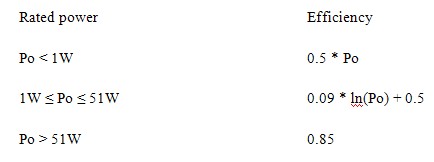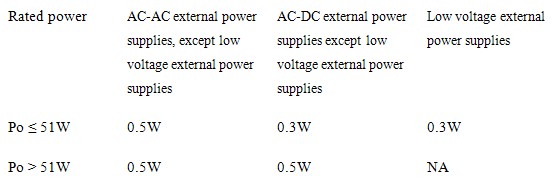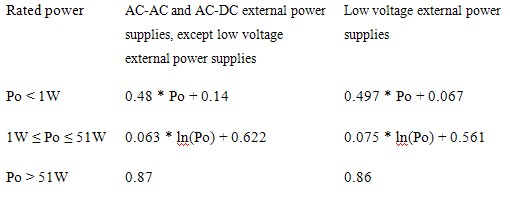
ECODESIGN
REFRIGERATORS AND FREEZERS
Exigencies for ecodesign for electric motors were stated in the
‘Commission Regulation (EC) No 643/2009 of 22 July 2009 implementing Directive 2005/32/EC of the European Parliament and of the Council with regard to ecodesign requirements for household refrigerating appliances (Text with EEA relevance)’
Generic requirements concerning refrigerators and freezers are listed below:
From 1 July 2010
• For appliances designed for wine storage the sentence ‘This appliance is intended to be used exclusively for the storage of wine’ shall be displayed in the brochure attached to the appliance.
• For the household refrigerating appliances the brochure attached to the appliance shall contain information concerning:
- combination of drawers, shelves and baskets that results with the most efficient energy usage by the appliance
- how to minimize the energy usage.
From 1 July 2013
• The fast freezing function, or any similar facility achieved through modification of the thermostat settings shall once activated by the user, automatically revert to the previous normal storage temperature states after no more than 72 hours. This requirement is omitted when refrigerator-freezers have one thermostat and one compressor which are equipped with an electromechanical control board.
• Refrigerator-freezers with one thermostat and one compressor which are equipped with an electromechanical control board which can be used in temperature below 16C shall, according to the manufacturer’s instructions, be automatically switched to the winter function or any other facility providing an appropriate temperature for the frozen food.
• Household refrigerating appliances with a storage volume below 10 litres shall automatically enter in an operating condition with a power consumption of 0W after no more than 1 hour when empty. The mere presence of a hard off switch shall not be considered sufficient to fulfil this requirement.
Specific requirements concerning refrigerators and freezers are listed below and they involve every refrigerator and freezers except wine storage systems and absorption-type refrigerating .
• For compression type refrigerating appliances:
- From 1 July 2010 the energy efficiency index (EEI) shall be less than 55.
- From 1 July 2012 the energy efficiency index (EEI) shall be less than 44.
- From 1 July 2014 the energy efficiency index (EEI) shall be less than 42.
• For absorption-type and other-type refrigerating appliances:
- From 1 July 2010 the energy efficiency index (EEI) shall be less than 150.
- From 1 July 2012 the energy efficiency index (EEI) shall be less than 125.
- From 1 July 2015 the energy efficiency index (EEI) shall be less than 110.
TELEVISIONS
Exigencies for ecodesign for electric motors were stated in the
‘Commission Regulation (EC) No 642/2009 of 22 July 2009 implementing Directive 2005/32/EC of the European Parliament and of the Council with regard to ecodesign requirements for televisions (Text with EEA relevance)’
Requirements for televisions in on mode are following:
From 20 August 2010
• TV sets in full HD should consume less energy than 20W + A * 1.12 * 4.3224 W/dm2
• TV sets in all other resolution should consume less energy than 20W + A * 4.3224 W/dm2
• TV monitors in full HD should consume less energy than 15W + A * 1.12 * 4.3224 W/dm2
• TV monitors in all other resolution should consume less energy than 15W + A * 4.3224 W/dm2
From 1 April 2012
• TV sets in all resolutions should consume less energy than 16W + A * 3.4579 W/dm2
• TV monitors in all resolutions should consume less energy than 12W + A * 3.4579 W/dm2
Where: A is visible screen area expressed in dm2.
Requirements for televisions in standby or off modes are following:
From 7 January 2010
• Energy consumption in off mode should not be more than 1W.
• Energy consumption in standby mode should not be more than 1W in condition providing only a reactivation function or reactivation function with a simple information of enabled reactivation function.
• Energy consumption in standby mode should not be more than 2W in condition providing a combination of a reactivation function and display status.
• Televisions should have an off-mode and/or standby mode and/or any other condition which does not consume more energy than pointed in three previous points while connected to the grid.
• If the television set consists of a display and of at least one tuner, receiver or any additional data storage and reading appliance such as DVD, VCR or HDD four previous points should be obtained for separate display and an additional appliance.
From August 2011
• Energy consumption in off mode should not be more than 0.3W. However in television sets with a visible switch which puts a tv in a condition with power consumption of less than 0.01W when operated in any off-mode should consume less energy than 0.5W.
• Energy consumption in standby mode should not be more than 0.5W in condition providing only a reactivation function or reactivation function with a simple information of enabled reactivation function.
• Energy consumption in standby mode should not be more than 1W in condition providing a combination of a reactivation function and display status.
• Televisions should have an off-mode and/or standby mode and/or any other condition which does not consume more energy than pointed in three previous points while connected to the grid.
• Television sets should include a power down function which will put a tv in a standby or off-mode after no less than 4 hours in on mode followed by no user interaction on the television. The function should provide a warning message before an automatic switch.
• If the television set consists of a display and of at least one tuner, receiver or any additional data storage and reading appliance such as DVD, VCR or HDD five previous points should be obtained for separate display and an additional appliance.
Requirements concerning peak luminance coefficient are following:
From 20 August 2010
• Peak luminance in televisions without forced menu in on mode which is determined by the producer should not be less than 65% of the peak luminance of the brightest on mode condition provided by the television.
• Peak luminance in televisions with forced menu in home mode should not be less than 65% of the peak luminance of the brightest on mode condition provided by the television.
The manufacturers shall also conceive the documentation about the product which provide following information:
• Test parameters for measurement such as ambient temperature, voltage and frequency, input terminal for audio and video signals and total harmonic disturbance of the electric system.
• On mode information
- Energy consumption in Watts.
- Characteristics of the dynamic broadcast-content video signal representing typical broadcast TV content.
- Sequence of steps which have to be realized to achieve a stable condition concerning the energy consumption.
- In addition for televisions with forced menu, the peak luminance coefficient in home mode and the brightest luminance available shall be provided in percents.
- In addition for television monitors, there has to be provided a description of relevant functions of the tuner used in measurement.
• Every standby or off mode
- Energy consumption in Watts.
- the measurement method used.
- Sequence of steps which have to be realized to achieve the mode where the TV automatically changes the modes.
- Description of how the mode was programmed.
• The information about the power down function.
• If the product contains the hazardous materials the information about mercury shall be provided in milligrams as well as the notification of the lead occurrence.
Additionally from 20 August 2010 the information about on mode, every standby or off mode, power down function and the occurrence of the hazardous materials shall be provided on the generally available internet web pages.
EXTERNAL POWER SUPPLIES
Exigencies for ecodesign for electric motors were stated in the
‘Commission Regulation (EC) No 278/2009 of 6 April 2009 implementing Directive 2005/32/EC of the European Parliament and of the Council with regard to ecodesign requirements for no-load condition electric power consumption and average active efficiency of external power supplies’
The requirements for energy consumption in no load condition and the minimal average efficiencies are following:
• One year after the ‘Commission Regulation (EC) No 278/2009’ has come into force:
- Energy consumption in no load shall not exceed 0.50W.
- Average efficiency shall not be less then:

• Two year after the ‘Commission Regulation (EC) No 278/2009’ has come into force:
- Energy consumption in no load shall not exceed:

- Average efficiency shall not be less then:

-
Definition of energy conservation and demand side management|
Technologies|
Financial funds|
Legislative and normative issues|
Data base
Copyrights © Arkadiusz Mysiakowski
